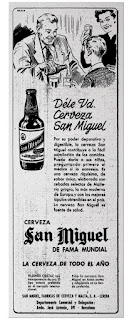Falling Back, 14 & 15. Sherry for Children
Yesterday was a very blue day, and when eight o'clock rolled around, I still had no idea what to write, except the refrain going through my head. The news about contagion was also depressing, and nothing new. And that wasn't at all interesting. So, I left it for today. An article this morning, in the blog Thoughts from Galicia, Spain, on the British scions of the sherry trade in southern Spain kicked off a memory.
The article mentioned a mix of sherry, egg yolk, and sugar that was given to children once, a long time ago, in the area of southwestern Andalucía, in the area where sherry is produced. It was (and still is) called candié, a corruption of the English candied egg. But this brew goes back quite a ways.
It was mentioned in a dictionary from 1729 as a way to season meat. But sixty years later, it was no longer mentioned as a seasoner, and simply a delicious drink. What is its possible origin is that it was thought up as a way to use left over egg yolks from sherry making. Sherry was made in the area of Jerez since the time of the Romans. Drake's looting of the port of Cádiz included sherry wine, which was very popular among the English. So popular, that at the end of the seventeenth, beginning of the eighteenth, several English families settled in the area and began to dominate the sherry market. They were the origin of the candié, or sherry flip as it's known elsewhere. To clarify sherry, egg whites were used, and to use up the yolks, someone decided to mix them with sherry. A vivacious tonic was born.
Back in the 1960's and 70's, it was common to give children sherry with egg yolk, to open up their appetite. Before, even. My mother-in-law said her grandmother would give it to her. I doubt my mother drank it, though. They were much poorer, and would sell the eggs. Only, instead of regular sherry, it was vino quinado. These were wines, always sherry, that had had quinine and sugar added to it, to make it a medicinal tonic. There were quite a few brands, but my mother bought for me Gran Vino Sansón, in a squarish bottle. In my memory, my mother bought it in North End's Martignetti Liquors. In itself, it was a tasty wine, but when she beat the egg yolk into it, I tried to find one hundred ways to avoid it. I would let it sit as long as possible, with my mother's eye on me, cajoling, and finally threatening me. The longer I waited, the more the yolk fell to the bottom. I would then drink it, but leave the liquid in the bottom of the glass, with the thickest part of the yolk. It became such a habit, I would leave the last bit of liquid of whatever I was drinking for many years.
Now, we know that alcohol is bad for children's development, but back then it was an
everyday thing that everyone partook of. From beer with gaseosa, a soft drink that tastes slightly like Sprite, to wine with gaseosa, so diluted as to be a light pink, children would sit at the table and drink like the grown-ups. Partly, as custom, and partly because water supplies were generally not potable for many years, until modern technology brought decent well water and spring water into the villages.Commercials and publicity targeted children, too. Cruzcampo beer ran a newspaper ad in the 1960's with children holding their own one liter bottle of beer. Another one shows a father pouring his child a glass of San Miguel beer. Kina San Clemente, a wine just like Gran Vino Sansón, even designed a cartoon kid called Kinito, and encouraged kids to send in proofs of purchase to receive a Kinito doll. He became quite popular, it seems, and the ads always encouraged kids to drink some of the wine with their afternoon sandwich, to open their appetite and eat more.
Granted, though, the anxiety of most parents to get their offspring to eat more came from the years of hunger and want. Back then, if a kid didn't have an appetite, most likely that kid would die of hunger, because there wasn't much food, and what there was had to be eaten to live. Childhood nutrition consisted in getting children to eat everything in front of them so they could survive. That mentality peristed many years, and my mother was a prime example.
I haven't tasted Gran Vino Sansón in a long time. It's still sold in the wine section of many supermarkets, along with many of the other brands. Some day I might buy a bottle, for memory's sake. But I'm drinking it straight, no egg.




I bought a bottle some years ago and it didn´t taste like I remember when I was a child.
ReplyDelete